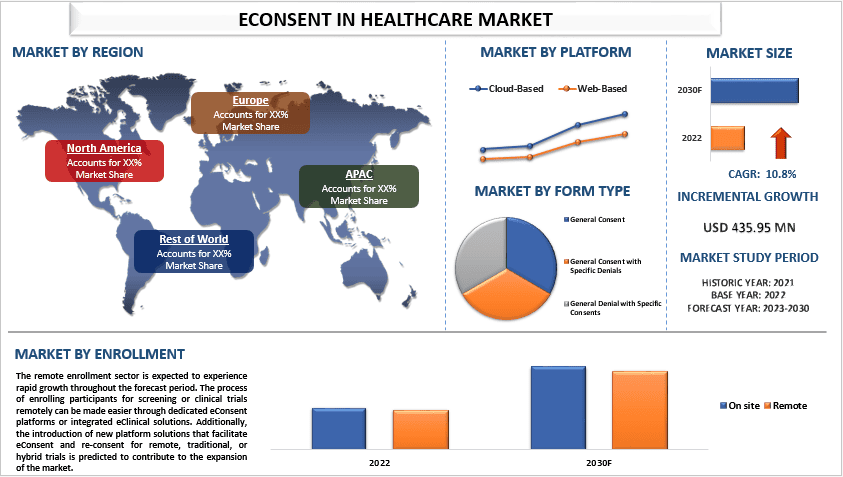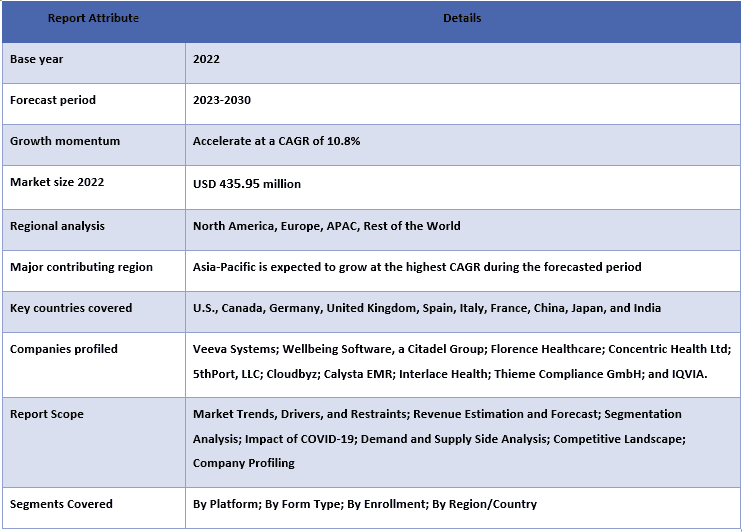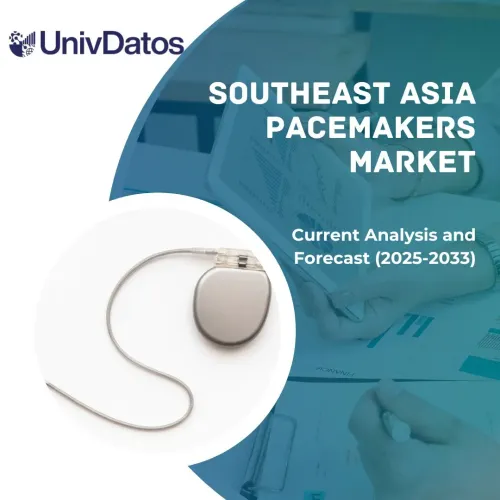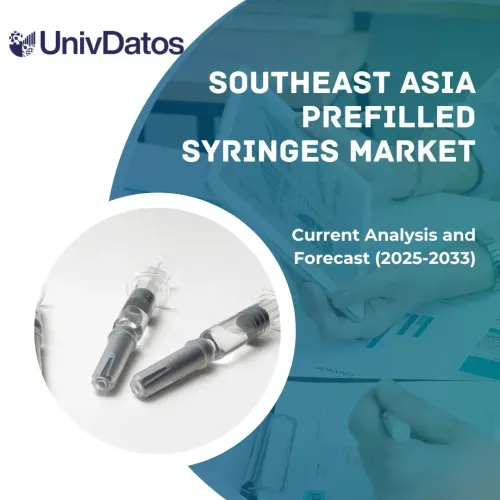- Home
- About Us
- Industry
- Services
- Reading
- Contact Us
eConsent in Healthcare Market: Current Analysis and Forecast (2023-2030)
Emphasis on Platform (Cloud Based and Web Based); Enrollment (On Site and Remote); Form Type (General Consent, General Consent With Specific Denials, General Denials With Specific Consents, and General Denials) Region/Country.

The eConsent in Healthcare Market was valued at USD 435.95 Million and is expected to grow at a strong CAGR of around 5.6% during the forecast period (2023-2030). Owing rising number of clinical trials. Econsent, short for electronic consent, refers to the process of obtaining an individual’s authorization or agreement using digital platforms or technologies, instead of traditional paper-based methods. This innovative approach holds immense significance in enhancing efficiency, accuracy, and patient satisfaction within the healthcare market. The healthcare sector has witnessed a steady transition towards digitization to streamline operations and improve patient care. The healthcare industry has witnessed an unprecedented rise in the number of clinical trials conducted worldwide. This surge in clinical trials can be attributed to various factors including advancements in medical research, increasing prevalence of chronic diseases, and growing demand for personalized medicine. As the number of clinical trials continues to soar, the need for efficient and streamlined processes becomes evident, and one notable area that has gained significant traction is the adoption of electronic informed consent (eConsent). Globally, clinical studies have increased from 2,119 in 2000 to 437,530 as of July 10, 2023. According to data gathered from ClinicalTrial.gov, there has been a 49.2% rise in clinical trials over the past 5 years. In 2018, there were 293,243 trials registered internationally. As of July 10, 2023, around 437,530 trials were registered. Clinical trial starts overall climbed by 23.6% in 2020, maintaining growth patterns from the previous 3 years and taking into consideration the speedy return to pre-COVID-19 levels that began in the middle of the year.
Some of the major players operating in the market are Veeva Systems; Wellbeing Software, a Citadel Group; Florence Healthcare; Concentric Health Ltd; 5thPort, LLC; Cloudbyz; Calysta EMR; Interlace Health; Thieme Compliance GmbH; and IQVIA. Several M&As along with partnerships have been undertaken by these players to facilitate customers with hi-tech and innovative products/technologies.
Insights Presented in the Report
“Amongst platfrom, the web based segment to grow with high CAGR during the forecast period”
Based on platform, the market is bifurcated into cloud based and web based. The web based segment is anticipated to grow with high CAGR during the forthcoming period. Web-based eConsent is based on obtaining information through a website or web-based application. It allows sites to obtain information unavailable over a paper process. This consent is accessible online; hence, users can access it as part of their website usage and get an online experience. Several companies are launching web-based software in the market, thus boosting the growth of the market. For instance, in 2022, Validic partnered with Cerner Corporation to integrate web-based e-consent solutions within Cerner’s electronic health record (EHR) system. This collaboration aimed to streamline the consent process for patients and healthcare providers. Further in 2023, Epic Systems Corporation, announced the launch of their web-based e-consent module, integrated within their comprehensive electronic medical record (EMR) system. This product launch aimed to provide a seamless consent management solution for Epic’s vast customer base.
“Amongst enrollment, the on site category to held dominant share of the market in 2022”
On the basis of enrollment, the market is bifurcated into on-site and remote. The on-site segment held dominant share of the market in 2022. The on-site segment of the eConsent market refers to the use of electronic consent systems within healthcare facilities such as hospitals and clinics. This segment is being driven by healthcare organizations seeking to improve efficiency and compliance in their informed consent processes. Key factors propelling adoption of on-site eConsent solutions include the need to eliminate paper-based consent forms, integrate consent processes into EHR systems, provide better transparency for patients, and adhere to changing regulations around consent documentation. Healthcare facilities are implementing on-site eConsent systems to provide patients with digitized consent materials that can be reviewed and signed electronically, usually via tablet devices. This transforms the consent process from a cumbersome, inconsistent paper workflow into a digital experience that is faster, more compliant, and more interactive for patients. The on-site eConsent market is expected to see significant growth as healthcare systems aim to improve patient satisfaction while also meeting their ethical and legal consent obligations.
“Amongst form type, the general denials with specific consent category to grow with significant CAGR during the forecast period”
On the basis of form type, the market is segmented into general consent, general consent with specific denials, general denials with specific consents, and general denials. The general denials with specific consents is anticipated to grow with high CAGR during the forthcoming period. While specific consent forms are essential for defining the boundaries of data usage or initiating specific actions, they typically do not provide organizations with unlimited access or entitlement to an individual’s data or rights. Organizations may have their own policies, ethical guidelines, or legal obligations which require them to exercise discretion and refuse requests, if necessary, despite obtaining specific consent. For instance, in the healthcare industry, patients’ consent forms are obtained for specific medical procedures or sharing of medical records with other providers. However, in certain cases, healthcare providers may exercise general denial if a patient’s request poses a risk to their health, violates legal regulations, or compromises the privacy of other individuals. These denials are part of the healthcare provider’s duty of care and ensure that they adhere to their legal and ethical obligations.
“Asia Pacific to grow with high CAGR during forecast period”
The Asia Pacific region is witnessing a growing demand for eConsent in the healthcare industry. This demand is driven by several factors, including the increasing burden of diseases, rapid economic development, and the widespread adoption of technology-based solutions such as cloud and web-based platforms in clinical trials. Additionally, there is a strong emphasis on research and clinical trials in hospitals and research centers in this region, which further fuels the need for digital solutions like eConsent.
eConsent in Healthcare Market Report Coverage

Reasons to buy this report:
- The study includes market sizing and forecasting analysis validated by authenticated key industry experts.
- The report presents a quick review of overall industry performance at one glance.
- The report covers an in-depth analysis of prominent industry peers with a primary focus on key business financials, product portfolios, expansion strategies, and recent developments.
- Detailed examination of drivers, restraints, key trends, and opportunities prevailing in the industry.
- The study comprehensively covers the market across different segments.
- Deep dive regional level analysis of the industry.
Customization Options:
The global econsent in healthcare market can further be customized as per the requirement or any other market segment. Besides this, UMI understands that you may have your own business needs, hence feel free to connect with us to get a report that completely suits your requirements.
Table of Content
Research Methodology for the eConsent in Healthcare Market Analysis (2023-2030)
Analyzing the historical market, estimating the current market, and forecasting the future market of the global econsent in healthcare market were the three major steps undertaken to create and analyze the adoption of econsent in healthcare in major regions globally. Exhaustive secondary research was conducted to collect the historical market numbers and estimate the current market size. Secondly, to validate these insights, numerous findings and assumptions were taken into consideration. Moreover, exhaustive primary interviews were also conducted, with industry experts across the value chain of the global econsent in healthcare market. Post assumption and validation of market numbers through primary interviews, we employed a top-down/bottom-up approach to forecasting the complete market size. Thereafter, market breakdown and data triangulation methods were adopted to estimate and analyze the market size of segments and sub-segments of the industry pertains to. Detailed methodology is explained below:
Analysis of Historical Market Size
Step 1: In-Depth Study of Secondary Sources:
Detail secondary study was conducted to obtain the historical market size of the econsent in healthcare market through company internal sources such as annual reports & financial statements, performance presentations, press releases, etc., and external sources including journals, news & articles, government publications, competitor publications, sector reports, third-party database, and other credible publications.
Step 2: Market Segmentation:
After obtaining the historical market size of the econsent in healthcare market, we conducted a detailed secondary analysis to gather historical market insights and share for different segments & sub-segments for major regions. Major segments are included in the report as platform, enrollment, and form type. Further country-level analyses were conducted to evaluate the overall adoption of testing models in that region.
Step 3: Factor Analysis:
After acquiring the historical market size of different segments and sub-segments, we conducted a detailed factor analysis to estimate the current market size of the econsent in healthcare market. Further, we conducted factor analysis using dependent and independent variables such as platform, enrollment, and form type of the econsent in healthcare market. A thorough analysis was conducted for demand and supply-side scenarios considering top partnerships, mergers and acquisitions, business expansion, and product launches in the econsent in healthcare market sector across the globe.
Current Market Size Estimate & Forecast
Current Market Sizing: Based on actionable insights from the above 3 steps, we arrived at the current market size, key players in the global econsent in healthcare market, and market shares of the segments. All the required percentage shares split, and market breakdowns were determined using the above-mentioned secondary approach and were verified through primary interviews.
Estimation & Forecasting: For market estimation and forecast, weights were assigned to different factors including drivers & trends, restraints, and opportunities available for the stakeholders. After analyzing these factors, relevant forecasting techniques i.e., the top-down/bottom-up approach were applied to arrive at the market forecast for 2030 for different segments and sub-segments across the major markets globally. The research methodology adopted to estimate the market size encompasses:
- The industry’s market size, in terms of revenue (USD) and the adoption rate of the econsent in healthcare market across the major markets domestically
- All percentage shares, splits, and breakdowns of market segments and sub-segments
- Key players in the global econsent in healthcare market in terms of products offered. Also, the growth strategies adopted by these players to compete in the fast-growing market
Market Size and Share Validation
Primary Research: In-depth interviews were conducted with the Key Opinion Leaders (KOLs) including Top Level Executives (CXO/VPs, Sales Head, Marketing Head, Operational Head, Regional Head, Country Head, etc.) across major regions. Primary research findings were then summarized, and statistical analysis was performed to prove the stated hypothesis. Inputs from primary research were consolidated with secondary findings, hence turning information into actionable insights.
Split of Primary Participants in Different Regions

Market Engineering
The data triangulation technique was employed to complete the overall market estimation and to arrive at precise statistical numbers for each segment and sub-segment of the global econsent in healthcare market. data was split into several segments & sub-segments post studying various parameters and trends in the areas of the platform, enrollment, and form type in the global econsent in healthcare market.
The main objective of the Global eConsent in Healthcare Market Study
The current & future market trends of the global econsent in healthcare market were pinpointed in the study. Investors can gain strategic insights to base their discretion for investments on the qualitative and quantitative analysis performed in the study. Current and future market trends determined the overall attractiveness of the market at a regional level, providing a platform for the industrial participant to exploit the untapped market to benefit from a first-mover advantage. Other quantitative goals of the studies include:
- Analyze the current and forecast market size of the econsent in healthcare market in terms of value (USD). Also, analyze the current and forecast market size of different segments and sub-segments
- Segments in the study include areas of the platform, enrollment, and form type
- Define and analysis of the regulatory framework for the econsent in healthcare industry
- Analyze the value chain involved with the presence of various intermediaries, along with analyzing customer and competitor behaviors of the industry
- Analyze the current and forecast market size of the econsent in healthcare market for the major region
- Major countries of regions studied in the report include Asia Pacific, Europe, North America, and the Rest of the World
- Company profiles of the econsent in healthcare market and the growth strategies adopted by the market players to sustain in the fast-growing market
- Deep dive regional level analysis of the industry
Frequently Asked Questions FAQs
Q1: What is the current market size and growth potential of the eConsent in healthcare market?
Q2: What are the driving factors for the growth of the eConsent in healthcare market?
Q3: Which segment has the largest share of the eConsent in healthcare market by form type?
Q4: What are the emerging technologies and trends in the eConsent in healthcare market?
Q5: Which region will dominate the vasculitis market?
Related Reports
Customers who bought this item also bought










